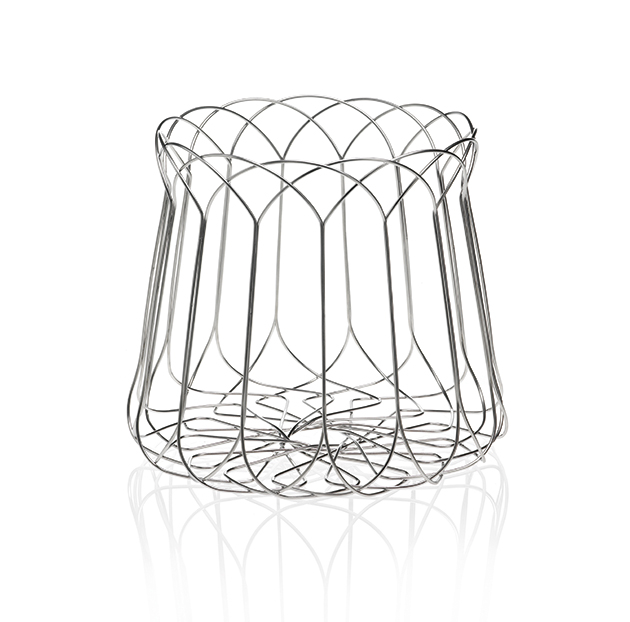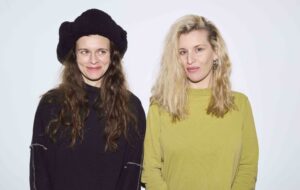 Portrait: Alberto Feltrin
Portrait: Alberto Feltrin
As the ubiquitous designer prepares to launch an exhibition looking back at the life of her mentor, Priya Khanchandani caught up with Patricia Urquiola in her Milan studio
Patricia Urquiola’s studio is in an unlikely location in the residential area of Porta Venezia in Milan, a series of angular spaces designed around a courtyard beneath her home. Inside, around 80 staff conjure up numerous projects under her direction, from interior design to products that experiment with form and fabric. Shelves and surfaces display all manner of prototypes, from a slate of marble patterned in the style of Missoni, to a wire basket that later formed a fruit bowl for Alessi. Having recently completed the interiors of a luxury residential property in London commissioned by LODHA and in the midst of designing the Achille Castiglioni exhibition opening at the Triennale di Milano in October, Urquiola spoke to Icon about her double role as an architect and designer. In a wide-ranging conversation, she reflects on the debt she owes to Castiglioni, the ways in which designers think and observe, the passage of time and the importance of ‘the space in the middle of the hourglass’. LA Sunset low tables for Glas Italia
LA Sunset low tables for Glas Italia
ICON: What are you working on at the moment?
Patricia Urquiola: This morning I was trying to finish the Castiglioni exhibition, which we are working on for the Triennale.We are completely focused on that.
ICON: So how were you approaching it? What is it about?
PU: I had the honour of being one of his students, at the Politecnico [di Milano]. And he was not only a teacher, he was a mentor. When I joined, I was only interested in doing architecture. And coming from Spain in the middle of my studies was unusual; this is before the Erasmus mentality.
ICON: So you moved from Spain to Italy?
PU: Yes. I had a lot of problems because there was no connection between the universities. Then I had to redo certain exams. And I met Castiglioni, and I could tell that he was different. And I began to focus on the idea of design and not the big A of architecture. And I became a designer because of him. So, to design an exhibition about this fantastic designer is a big honour for me.
PU: You know the hourglass we did for LODHA?
ICON: Yes, could you tell me about it?
PU: It’s an inclusion between the two elements of the passage of time. When you’re thinking about the passage from one point of time to another, what happens in the middle is very important. Many times, when we are doing a project with a short deadline and my studio are nervous, I say, ‘Don’t think in days, think in minutes or seconds. Then we have a lot of time.’
 The hourglass commissioned for the Lincoln Square development in London
The hourglass commissioned for the Lincoln Square development in London
ICON: Since you manage a substantial commercial practice, how do you negotiate that creative space and creative time?
PU: You have a particular concept of process. It’s something that you have very clear inside you, part of your method of thinking; of, you know, ‘I’m doing a project, but I need to stop and read a book that could be interesting for that project.’ Then you connect the project with all of these things. I think it is Proustian in some ways: the idea that you’re living, you’re doing something, but at a certain moment you make connections to other things that have happened to you and things that are relative. I go forward and backwards, up and down and sideways: that is fundamentally my way of thinking about a project.  Spirogira wire basket for Alessi
Spirogira wire basket for Alessi
ICON: Is there anything particular, at the moment, that you are drawing on, reading, or thinking about, which influences you?
PU: The case of this exhibition is very complex because we’re trying to understand his [Castiglioni’s] mind. We’re not working along a timeline but thematically. It’s the only way to represent him: he was so creative. We want to make connections between arguments, and place the products related in between them, kind of like a rhizome. I believe rhizomic relations occur in everything, not only in botany. I think we now live in a society that is fully connected, and you have to understand the time you’re living in.
ICON: What is it about objects that fascinates you?
 The Mirage rug by the Spanish company Gan
The Mirage rug by the Spanish company Gan
PU:I think Castiglioni was part of it. At one point, I was only seen as a product designer. But when I was working with companies, I kept saying, ‘No, I don’t like the way you are doing this space. This is not connected with that.’ And then, they began to say, ‘Well, can you interact with the architecture, too?’ And I began to do a lot more architecture.
And I began to understand that I like to focus on products and work with industry in a certain way. Or in a crafted way – that’s another side of my work. Many of the things that happen in my architecture have to do with rethinking wood or marble, or rethinking a carpet, or rethinking the dimensions or light. For me, all these things are part of the project. A work of architecture can give me the possibility of rethinking surface and materiality. And I often mix the different sides of my work.
ICON: One of the projects I found interesting is the Cassina 9.0 exhibition last year at the Fondazione Giangiacomo Feltrinelli.
PU: We were celebrating 90 years of the company. And I was saying, with a company that was working and doing products, I don’t want to do an exhibition that is only about the past, because then we become old. The only way to get over your age – to get this space in the middle of the sand timer – is to look at the company in another way, to think about the possible future of the company. The title was Cassina 9.0, not ’90,’ and each section was numbered 9.1, 9.2 and so on.
I put in projects from the past with those from the future and had the walls react to them. I wanted it to think of the future in a very open, playful way.
ICON: How do you think design can evolve to face the actuality of the changing face of technology in the home?
PU: Design is a discipline that is connected with social values. To work in design, you have to think a lot about how people live. And then you have to be a very good observer. Because why create new objects, why create a new place for a city, if you’re not thinking about how things can change and evolve?
 Liquefy console in tempered glass for Glas Italia
Liquefy console in tempered glass for Glas Italia
Rethinking, redesigning: there are many ways to innovate. And when you analyse all these things you have to create your synthesis. You need a lot of curiosity about the society in which you live in order to have a point of view [and] to have new ideas, new solutions. And you want people to be comfortable with new concepts of light and space.
ICON: You used the word comfort. Is that important to you as a designer?
PU: My work is to create tools and spaces in which people can feel a sort of mental comfort. Don’t think ergonomic comfort; mental comfort is something more complex. Say you put a new chair in your house – when you situate it, it has to feel comfortable alongside other objects. It’s performing a transformation of the space.
ICON: You’re interested in creating new things, but the hourglass commissioned by LODHA shows that you’re still working with craft and tradition. Does that matter to you?
PU: Absolutely. I don’t think you can have an innovative attitude towards anything if you are not very comfortable with your memory. What I want to say is, don’t live in a stupid liquid present [in a way] that I think is very possible today; a liquified present where you don’t have perspective. You need to have a very clear idea of your memory, and to be able to connect to it when you wish; and then, like this, to critique the objects of your memory, innovate and do something for the future. Only when you know how to move between past, present and future, can you have a nice perspective of the future.
















